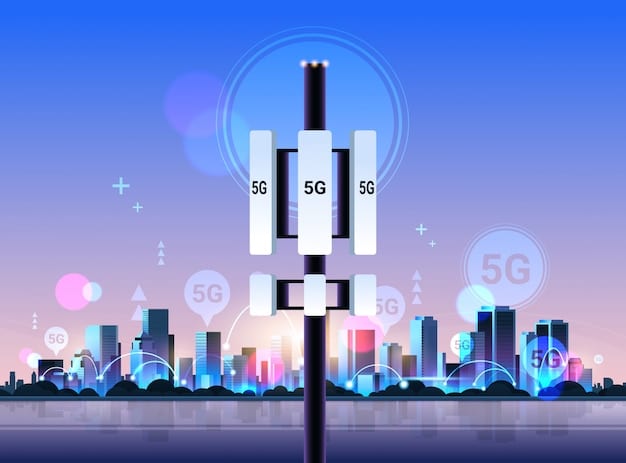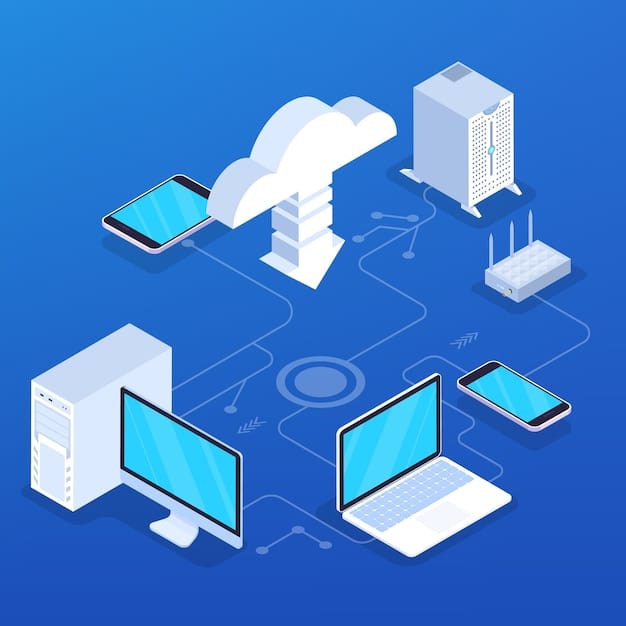The Future of 5G in the US: New Use Cases & Industry Partnerships

The future of 5G in the US promises to revolutionize connectivity through diverse new use cases, ranging from enhanced mobile broadband to the Internet of Things, driven by strategic industry partnerships across technology, automotive, healthcare, and manufacturing sectors.
The landscape of wireless technology is rapidly evolving, and at its forefront is 5G, poised to redefine how we connect, work, and live. As we look ahead, the future of 5G in the US: exploring new use cases and industry partnerships suggests a transformative era, moving beyond mere speed enhancements to underpin fundamental shifts across various sectors. This next generation of connectivity is not just faster; it’s a foundation for innovation, enabling applications and services that were once confined to science fiction.
The Evolution of 5G: From Concept to Commercial Deployment
The journey of 5G from a theoretical concept to widespread commercial deployment has been marked by significant milestones and continuous innovation. Initially envisioned as a successor to 4G LTE, 5G has surpassed expectations, offering not only higher speeds but also lower latency and the capacity to connect a massive number of devices. This evolution fundamentally changes our understanding and utilization of wireless technology, laying the groundwork for unprecedented connectivity.
Key Milestones in 5G Development
The development of 5G involved years of research, standardization, and extensive trials. Key phases included:
- Early Research & Standardization: Beginning in the mid-2010s, global consortiums like the 3GPP began defining the technical specifications for 5G, aiming for a unified global standard.
- Spectrum Auctions & Allocation: Governments worldwide, including the US, conducted auctions for valuable spectrum bands—low-band, mid-band, and high-band (mmWave)—crucial for 5G’s diverse capabilities.
- Initial Commercial Launches: Major carriers in the US started rolling out limited 5G services in 2018-2019, initially focusing on fixed wireless access and then expanding to mobile broadband.
The transition from 4G to 5G represents a leap in network capabilities. While 4G revolutionized mobile internet and enabled the smartphone era, 5G aims to support a much broader range of applications, from critical communication to industrial automation. This progression demonstrates a commitment to advancing digital infrastructure, ensuring that the US remains competitive in the global technology landscape.
The initial focus on deploying 5G in urban centers is now expanding into suburban and rural areas. This broader coverage will unlock the true potential of 5G, moving beyond early adopter markets to a more pervasive and impactful presence. The scale and speed of this rollout are critical for realizing the myriad benefits promised by the technology.
Transformative New Use Cases Driven by 5G
Beyond faster mobile downloads, 5G’s true power lies in its ability to enable a new generation of applications and services. These transformative use cases span multiple industries, promising to revolutionize daily life and economic activity. The inherent features of 5G, such as ultra-low latency, massive connectivity, and high bandwidth, are the catalysts for these innovations.
Enhanced Mobile Broadband (eMBB)
While often cited, enhanced mobile broadband is more than just speed. It’s about delivering consistent, high-quality connectivity for demanding applications:
- High-Resolution Streaming: Seamless 4K/8K video streaming and virtual reality content on mobile devices without buffering.
- Cloud Gaming: Low-latency cloud gaming experiences, making powerful console-level gaming accessible on any device.
- Immersive AR/VR Experiences: Richer augmented and virtual reality applications for entertainment, education, and professional training.
This enhanced capability transforms the way consumers interact with content and data, making real-time, high-fidelity experiences possible on the go. The ability to access vast amounts of data quickly and reliably opens doors for richer human-computer interactions and entertainment. It also supports increasingly complex applications directly on handheld devices, reducing reliance on local processing power.
Critical Communications & Smart Infrastructure
The low-latency capabilities of 5G are crucial for applications where real-time responsiveness is paramount. This includes public safety, smart city initiatives, and connected vehicles.
Imagine traffic lights adjusting dynamically based on real-time traffic flow, or emergency services having immediate access to critical data from incident scenes. These examples highlight 5G’s foundational role in building smarter, safer communities. The precision and reliability offered by 5G networks are unparalleled, making them indispensable for sensitive operations where even milliseconds count.

Industry 4.0 and Manufacturing Transformation
5G will play a pivotal role in the fourth industrial revolution, enabling factories and industrial environments to become fully connected and intelligent. This includes:
- Automated Guided Vehicles (AGVs): Enabling the precise navigation and coordination of autonomous robots within factories.
- Predictive Maintenance: Real-time monitoring of machinery with IoT sensors to predict failures and reduce downtime.
- Remote Operations: Allowing skilled workers to control machinery or perform complex tasks remotely with high precision.
The integration of 5G in manufacturing promises to increase efficiency, reduce operational costs, and enhance safety. By providing robust, low-latency private networks, 5G facilitates the collection and analysis of massive datasets, leading to smarter decision-making and optimized production processes. This level of automation and data integration represents a significant leap forward in industrial productivity.
Healthcare Innovation and Telemedicine
In healthcare, 5G opens avenues for advanced telemedicine, remote patient monitoring, and even remote surgery:
- Remote Diagnostics: High-bandwidth 5G enables the transmission of large medical images and video for remote diagnosis by specialists.
- Connected Wearables: Continuous, real-time monitoring of vital signs from connected health devices, alerting practitioners to anomalies.
- Tele-surgery & Robotics: The extremely low latency allows surgeons to operate robotic arms remotely with precise control, potentially aiding in areas with limited medical specialists.
These applications aim to improve access to quality healthcare, especially in underserved areas, and enhance patient outcomes through continuous monitoring and quicker responses. The ability to reliably transmit sensitive medical data and control complex equipment from a distance is a game-changer for medical accessibility and efficiency.
Augmented and Virtual Reality (AR/VR) for Enterprise
Beyond entertainment, AR/VR powered by 5G offers immense potential for enterprise applications. This includes:
- Remote Expert Assistance: Field technicians can receive real-time visual guidance from experts located anywhere, overlaying instructions onto their view.
- Immersive Training Simulations: Creating realistic training environments for hazardous or complex tasks, reducing risks and costs.
- Collaborative Design: Engineers and designers can work together on 3D models in a shared virtual space, regardless of their physical location.
These enterprise use cases are set to transform training, maintenance, and collaborative workflows. 5G’s capacity to handle vast amounts of data with minimal delay is crucial for rendering complex AR/VR environments smoothly, making these technologies viable for practical business applications.
Industry Partnerships: Catalysts for 5G Adoption
The widespread adoption and realization of 5G’s potential depend heavily on robust industry partnerships. No single entity can develop the entire ecosystem; collaboration is essential for innovation, infrastructure development, and creating compelling use cases. These alliances bridge the gap between network providers, technology developers, and end-users across various sectors.
Telecom Carriers and Equipment Manufacturers
At the core of 5G deployment are the partnerships between telecom carriers (e.g., Verizon, AT&T, T-Mobile) and equipment manufacturers (e.g., Ericsson, Nokia, Samsung). These collaborations are vital for:
- Infrastructure Rollout: Accelerating the deployment of 5G base stations, antennas, and core network elements.
- Technological Advancements: Collaborating on research and development to push the boundaries of 5G capabilities, including new spectrum utilization and network slicing.
- Standardization Efforts: Working together to ensure global interoperability and consistent performance of 5G networks and devices.
These foundational partnerships ensure that the underlying technology and infrastructure are robust, scalable, and secure, forming the backbone of the 5G ecosystem. Their continued investment and innovation are crucial for the ongoing expansion and enhancement of 5G services across the US.
Automotive Sector Collaborations
The automotive industry is a prime example of 5G-driven partnerships. Carmakers are collaborating with telecom providers and tech companies to enable connected and autonomous vehicles.
This includes developing Vehicle-to-Everything (V2X) communication, which allows vehicles to communicate with each other, roadside infrastructure, and pedestrians. Such capabilities are fundamental for improving road safety, optimizing traffic flow, and eventually enabling fully autonomous driving. The intricate requirements of real-time data exchange in this sector necessitate deep integration between network and vehicle technologies.
Consider the interplay required for a self-driving car to instantly receive data from a traffic light about its status or to communicate its intent to another vehicle milliseconds before a potential collision. This level of immediate, reliable communication is only possible with 5G’s low latency and high bandwidth, underlining the critical nature of these cross-industry partnerships.
Healthcare and Technology Alliances
As 5G reshapes healthcare, partnerships between healthcare providers, medical device manufacturers, and tech companies are emerging. These collaborations focus on:
- Remote Patient Monitoring Solutions: Developing secure, reliable platforms for transmitting health data from wearables and home devices.
- Telemedicine Platforms: Enhancing video consultation quality and enabling remote diagnostics for a broader range of conditions.
- AI-Powered Healthcare: Integrating AI with 5G networks to analyze vast medical datasets, assisting in diagnostics and personalized treatment plans.
These alliances aim to leverage 5G to make healthcare more accessible, efficient, and personalized, ultimately improving patient outcomes. The security and privacy of health data are paramount, making trusted partnerships essential for this sensitive sector.
Cross-Industry Ecosystem Building
Beyond specific sector partnerships, a broader ecosystem of collaboration is vital. This involves:
- Smart Cities Initiatives: Municipalities partnering with tech companies and network providers to deploy 5G for public services, traffic management, and environmental monitoring.
- Academic and Research Institutions: Collaborating with industry to explore new 5G applications, conduct trials, and develop future generations of wireless technology.
- Startups and Innovators: Providing platforms and support for smaller companies to build novel 5G-enabled solutions, fostering a dynamic environment for innovation.
These diverse partnerships create a synergistic environment where ideas can flourish, technologies can be integrated, and innovative solutions can be brought to market quickly. The collective effort ensures that the benefits of 5G are maximized across all facets of society and economy.
Addressing Challenges and Ensuring Widespread Adoption
Despite the immense promise, the path to widespread 5G adoption is not without its challenges. These include infrastructure deployment hurdles, security concerns, regulatory complexities, and the need for new business models. Addressing these issues systematically is crucial for unlocking 5G’s full potential across the US.
Infrastructure Deployment and Spectrum Availability
Rolling out a dense 5G network requires significant investment and logistical effort. Challenges include:
- Fiber Backhaul: Ensuring sufficient fiber optic connectivity to 5G cell sites, which is essential for handling massive data volumes.
- Permitting and Site Acquisition: Streamlining local regulations and gaining access to suitable locations for new base stations, especially for mmWave deployments.
- Spectrum Availability: Securing access to harmonized and sufficient spectrum across different bands to support diverse 5G services.
Overcoming these infrastructure challenges requires close cooperation between federal, state, and local governments, as well as private sector investment. Policy frameworks that encourage and facilitate infrastructure deployment are vital for accelerating the rollout.

Security and Privacy Considerations
As 5G connects an unprecedented number of devices and critical infrastructure, security becomes paramount. The expanded attack surface demands robust solutions:
- Network Slicing Security: Ensuring that individual network slices for different use cases remain isolated and secure.
- IoT Device Security: Protecting billions of connected IoT devices from cyber threats and ensuring data integrity.
- Data Privacy: Implementing strict protocols and regulations to protect user data transmitted over 5G networks.
Addressing these concerns involves a multi-layered approach, combining advanced encryption, threat detection, and stringent regulatory oversight. Collaboration between cybersecurity experts, network operators, and device manufacturers is essential to build a resilient and trustworthy 5G ecosystem.
Regulatory Frameworks and Policy Support
Effective regulatory frameworks are crucial for fostering a competitive and innovative 5G market. Key aspects include:
- Streamlined Permitting: Policies that accelerate the construction of 5G infrastructure without compromising local needs.
- Spectrum Reform: Allocating and managing spectrum efficiently to meet the growing demands of 5G services.
- Interoperability Standards: Ensuring that devices and networks from different vendors can seamlessly interact, promoting choice and competition.
Government policies that support investment, encourage innovation, and address market distortions are fundamental to enabling 5G’s widespread impact. Clear and consistent regulations provide certainty for investors and accelerate deployment.
New Business Models and Monetization Strategies
Monetizing 5G’s capabilities requires rethinking traditional business models. For instance, network slicing allows carriers to offer customized network segments with guaranteed performance for specific applications. This opens avenues for:
- Vertical-Specific Services: Offering tailored 5G solutions for industries like manufacturing, logistics, or healthcare.
- Edge Computing Services: Providing low-latency data processing capabilities closer to the data source, driving new revenue streams.
- API Monetization: Exposing network capabilities through APIs for developers to build innovative applications and services.
The shift from selling raw connectivity to value-added services is critical. Innovating business models will ensure that the significant investments in 5G infrastructure yield sustainable returns, fostering further development and expansion.
The Impact of 5G on Economic Growth and Innovation
5G is more than just a technological upgrade; it is an economic growth engine. Its pervasive influence on various sectors is expected to generate significant economic value, foster innovation, and create new job opportunities across the US. The ripple effect of enhanced connectivity extends far beyond the telecom industry itself.
Driving Job Creation and Workforce Development
The deployment and maintenance of 5G networks, coupled with the development of 5G-enabled applications, are expected to create thousands of new jobs. This includes roles in:
- Network Engineering and Deployment: Technicians and engineers for building and maintaining 5G infrastructure.
- Software Development: Programmers and developers specializing in 5G-specific applications, IoT solutions, and AI integration.
- Data Analytics: Professionals to process and derive insights from the vast amounts of data generated by connected devices.
Furthermore, 5G will necessitate a re-skilling and up-skilling of the existing workforce to adapt to new technologies and job requirements, fostering a more digitally literate and competent labor force. This investment in human capital is as crucial as the physical infrastructure.
Boosting Productivity Across Industries
The enhanced capabilities of 5G are set to significantly boost productivity across diverse industries:
- Manufacturing: Real-time process optimization, automated quality control, and reduced downtime through predictive maintenance.
- Logistics and Supply Chain: Improved tracking, automated inventory management, and optimized routes for delivery services.
- Agriculture: Precision farming enabled by IoT sensors and drones, leading to optimized resource use and increased yields.
By enabling more efficient operations, real-time data analysis, and unprecedented levels of automation, 5G promises to unlock substantial productivity gains, contributing to increased economic output and competitiveness for businesses operating within the US.
Fostering a Culture of Innovation
5G provides a robust platform for future innovation, encouraging startups and established companies alike to explore new possibilities. The guaranteed low latency and high bandwidth make previously conceptual ideas feasible. This environment leads to:
- New Service Offerings: Development of entirely new services and applications specifically designed to leverage 5G’s unique attributes.
- Cross-Industry Convergence: Facilitating collaboration and innovation at the intersection of different sectors, such as healthcare and manufacturing or automotive and smart cities.
- Research and Development Investment: Motivating increased investment in R&D to push the boundaries of what 5G can achieve and to develop future connectivity standards.
The availability of such advanced technological infrastructure acts as a magnet for talent and investment, reinforcing the US’s position as a global leader in technological advancement. The cycle of innovation fueled by 5G is just beginning, and its long-term impact on the economy is expected to be profound.
Ethical Considerations and Societal Impact of 5G
As 5G becomes more integrated into the fabric of society, it is essential to consider its ethical implications and broader societal impact. Beyond the technological advancements and economic benefits, thoughtful consideration of issues like digital divide, privacy, and responsible AI deployment is crucial for ensuring a positive and equitable future.
Addressing the Digital Divide
While 5G promises widespread connectivity, there is a risk it could exacerbate the digital divide if not deployed equitably. Ensuring access for all, particularly in rural and underserved urban areas, is a critical challenge. Strategies to mitigate this include:
- Universal Service Funds: Utilizing government programs to subsidize deployment in economically challenging areas.
- Public-Private Partnerships: Collaborating to extend 5G infrastructure to remote communities.
- Affordability Programs: Initiatives to ensure that 5G services are accessible and affordable for low-income households.
Equitable access is not just about technology; it’s about social equity. Bridging this divide ensures that all segments of society can benefit from the opportunities presented by advanced connectivity for education, healthcare, and economic participation.
Privacy in an Ultra-Connected World
The sheer volume of data generated and transmitted over 5G networks, especially from IoT devices, raises significant privacy concerns. Protecting individual data, from location information to health metrics, becomes increasingly complex. Key ethical considerations include:
- Data Anonymization and De-identification: Implementing robust techniques to protect individual identities within large datasets.
- Consent Mechanisms: Ensuring clear, transparent processes for obtaining user consent for data collection and usage.
- Regulatory Oversight: Developing and enforcing strong data protection laws to safeguard privacy rights.
A balance must be struck between leveraging data for innovation and ensuring that individual privacy is not compromised. Building public trust in 5G technologies hinges on robust privacy protections.
Responsible AI and Automation Deployment
5G will accelerate the deployment of AI and highly automated systems, from autonomous vehicles to intelligent factories. This raises ethical questions about job displacement, algorithmic bias, and accountability for AI decisions. Responsible deployment requires:
- Ethical AI Guidelines: Developing frameworks that ensure AI systems are fair, transparent, and operate within ethical boundaries.
- Workforce Retraining: Investing in programs to help workers adapt to roles augmented or replaced by automation.
- Clear Accountability: Establishing clear lines of responsibility for decisions made by autonomous systems.
The integration of 5G and AI holds immense potential, but society must proactively address these ethical dimensions to maximize benefits while mitigating risks. This foresight ensures that technological progress serves humanity rather than creating unforeseen problems.
| Key Point | Brief Description |
|---|---|
| 🚀 New Use Cases | Beyond speed, 5G enables immersive AR/VR, critical communications, and advanced IoT for industries. |
| 🤝 Industry Partnerships | Collaborations between telecom, automotive, healthcare, and tech drive 5G adoption and innovation. |
| 🚧 Challenges & Solutions | Addressing infrastructure deployment, security, and regulatory complexities is key for widespread impact. |
| 📈 Economic Growth | 5G fosters job creation, boosts productivity, and enhances innovation across various US sectors. |
Frequently Asked Questions about 5G in the US
▼
5G’s primary advantage over 4G LTE extends beyond just faster speeds. It offers ultra-low latency, crucial for real-time applications like autonomous vehicles and remote surgery, and massive connectivity, enabling billions of IoT devices. This combination unlocks new capabilities previously impossible with 4G, fundamentally transforming industries and daily life through more efficient and responsive networks.
▼
5G will revolutionize manufacturing by enabling Industry 4.0, or the fourth industrial revolution. It facilitates highly automated factories with real-time data exchange between machines and systems. This leads to predictive maintenance, optimized supply chains, and remote control of industrial machinery. The low latency and high reliability of 5G networks are critical for complex, synchronized industrial operations.
▼
Widespread 5G adoption in the US faces several challenges, including the massive investment required for dense infrastructure deployment, particularly fiber backhaul to cell sites. Regulatory hurdles and permitting issues for new cell towers can slow rollout. Additionally, ensuring robust cybersecurity for a vastly expanded connected ecosystem and developing new business models to monetize 5G capabilities are significant hurdles.
▼
Yes, ethical concerns surrounding 5G deployment include the risk of exacerbating the digital divide if rural and underserved areas lack access to advanced connectivity. Data privacy is another major concern, as 5G facilitates the collection of vast amounts of sensitive information from connected devices. Finally, the societal impact of increased automation and AI, including potential job displacement, requires careful management and ethical guidelines.
▼
Industry partnerships are crucial because no single entity possesses all the expertise and resources to fully realize 5G’s potential. Collaborations between telecom carriers, equipment manufacturers, tech companies, and vertical industries (automotive, healthcare) accelerate infrastructure deployment, foster innovation in new use cases, and ensure interoperability. These alliances drive the development of a comprehensive 5G ecosystem, unlocking its full transformative power.
Conclusion
The trajectory of 5G in the US points towards a future defined by unprecedented connectivity, transformative applications, and collaborative innovation. Moving beyond mere technological advancements, 5G is setting the stage for profound shifts across industries, from self-driving cars to advanced telemedicine and intelligent factories. While significant challenges remain in infrastructure deployment, security, and equitable access, strategic industry partnerships and forward-thinking policy frameworks are positioned to overcome these hurdles. The promise of 5G extends far beyond faster internet; it represents a fundamental re-imagining of how data flows, how industries operate, and ultimately, how society progresses in an increasingly connected world. As this powerful technology continues to evolve, its impact on the nation’s economic growth, innovation landscape, and daily life will undoubtedly be extensive and enduring, shaping the very fabric of the 21st century.





